Lightning is a dazzling natural phenomenon that captivates and sometimes frightens us with its awe-inspiring power. This electrical discharge occurs during thunderstorms when atmospheric conditions create an imbalance of electric charges between clouds and the ground. While we often associate this phenomenon with the bright flashes that streak across the sky, there are actually several distinct types, each with its unique characteristics and behavior.
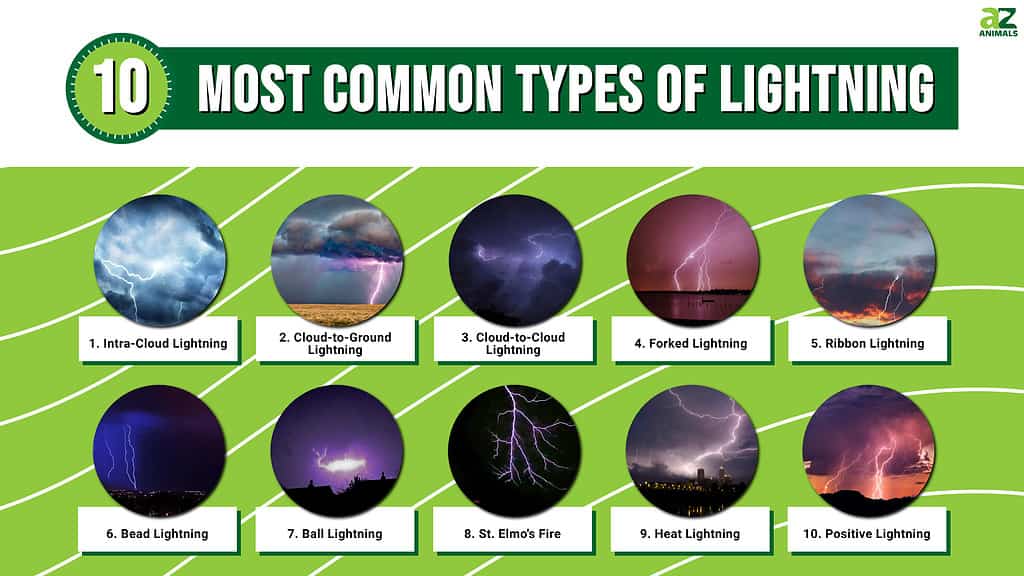
1. Intra-Cloud Lightning (IC)
Intra-cloud lightning, also known as “sheet lightning,” is the most common type. It occurs entirely within a single thundercloud, where different areas of the cloud develop regions of positive and negative charge. The electrical discharges within the cloud create brilliant flashes of light that often illuminate the entire cloud mass, giving it a “sheet-like” appearance. These discharges can take various forms, such as forked or branching patterns. Intra-cloud lightning is less hazardous to ground-level objects and humans, but its spectacular displays contribute to the captivating beauty of thunderstorms.
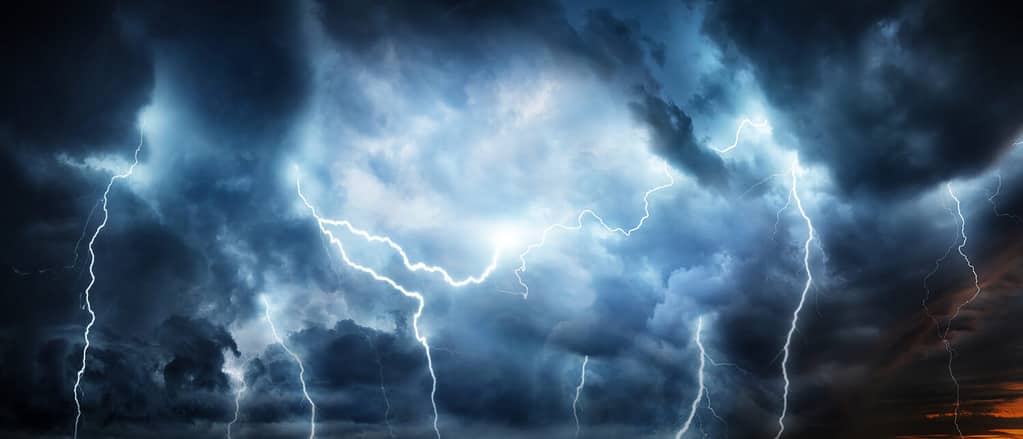
Intra-cloud electric events are the most common type and occur within a single thundercloud, giving a sheet-like appearance.
©Triff/Shutterstock.com
2. Cloud-to-Ground Lightning (CG)
Cloud-to-ground lightning is one of the most well-known and dramatic types. It occurs when electrical discharges extend from a thundercloud to the ground. The bolt typically consists of a “leader” stroke and a subsequent “return stroke.” The leader stroke is a channel of ionized air that descends from the cloud, while the return stroke is the bright, visible flash that travels back to the cloud along the same path. Cloud-to-ground lightning can strike the ground or objects on the ground, posing significant risks to human safety and property damage.
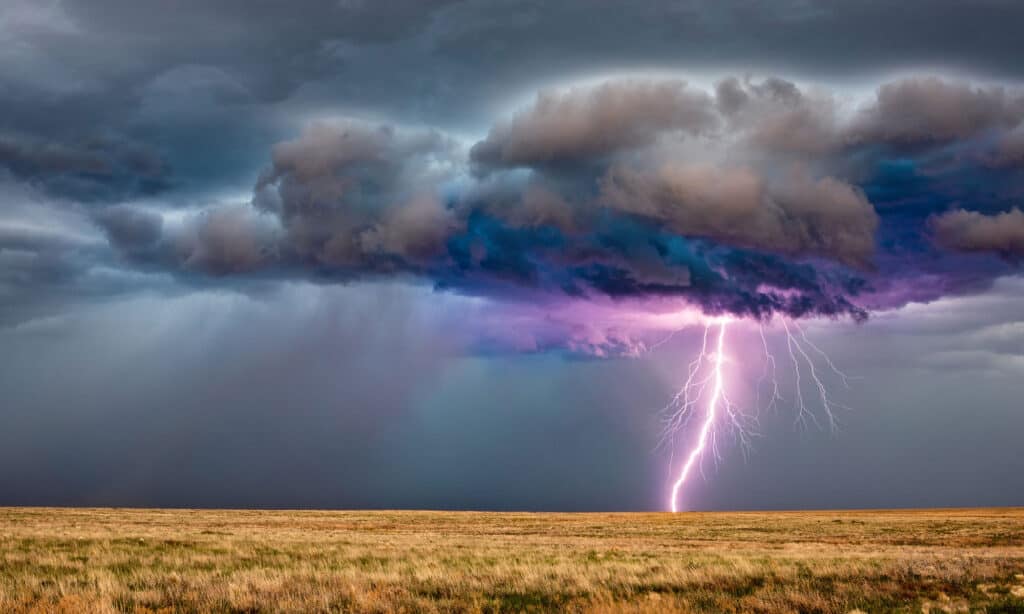
Cloud-to-ground events usually strike on the ground and return back along the same path, causing destruction where they hit.
©iStock.com/mdesigner125
3. Cloud-to-Cloud Lightning (CC)
Cloud-to-cloud lightning occurs when electrical discharges travel between different thunderclouds. This type is visible as a bright flash that illuminates the sky and thunder often accompanies it. Cloud-to-cloud lightning is less hazardous than cloud-to-ground lightning since it does not directly impact the Earth’s surface. However, it still plays a crucial role in the overall electrical activity within thunderstorms and contributes to the majestic display of lightning during a storm.
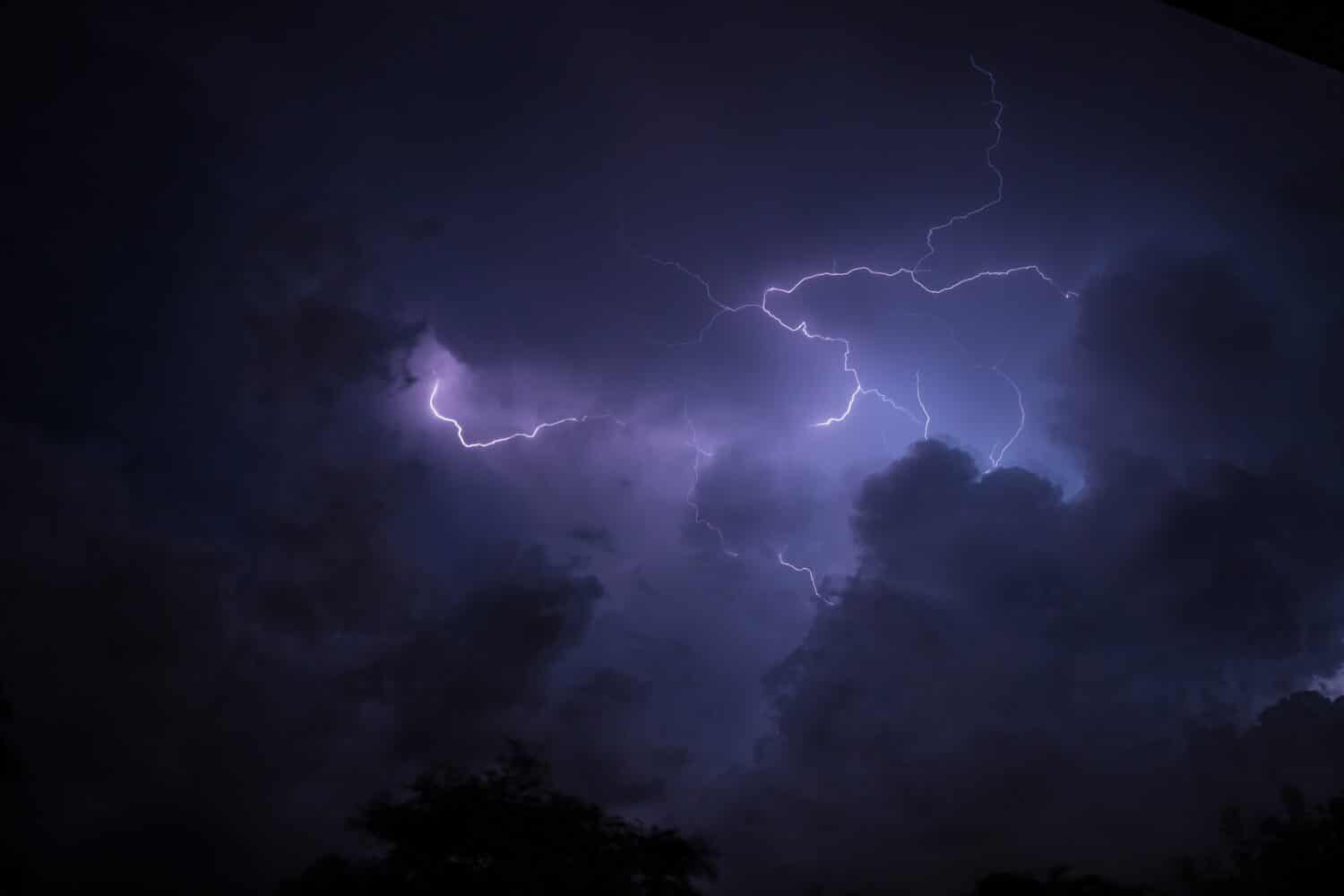
Cloud-to-cloud events are electrical connections between different clouds.
©Timodaddy/Shutterstock.com
4. Forked Lightning
Forked lightning is a mesmerizing and often dramatic type characterized by its striking resemblance to a fork or branching pattern. Both intra-cloud and cloud-to-ground lightning discharges can show this pattern. The branching appearance of the lightning bolt occurs due to the complex pathways of ionized air created during the discharge. Forked bolts are a common sight during intense thunderstorms, and their spectacular displays have been a subject of fascination and fear throughout history.
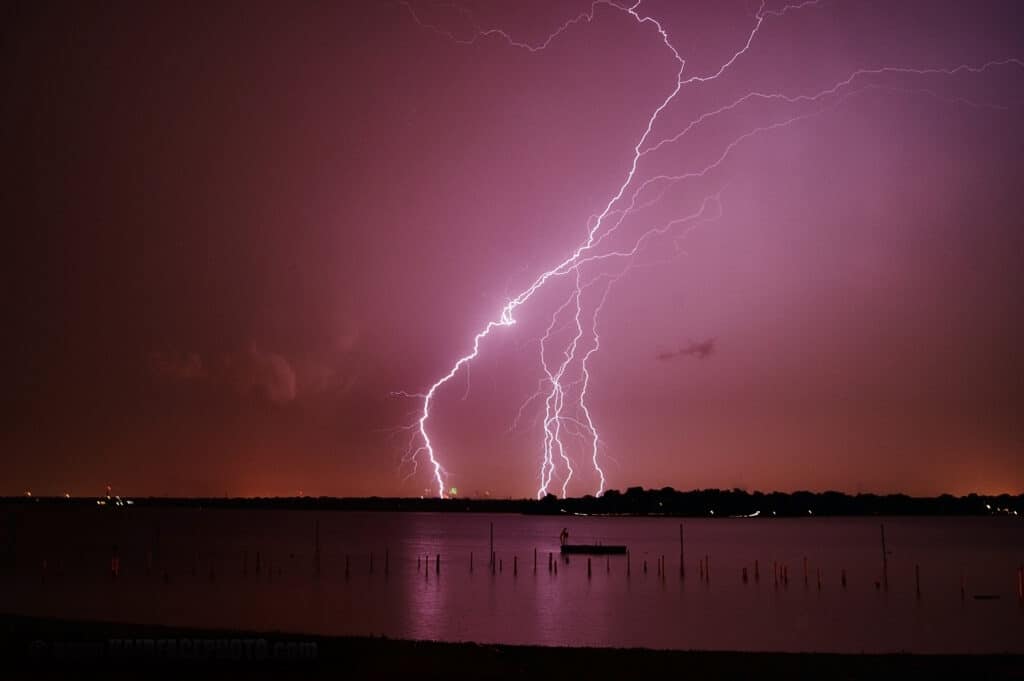
Forked bolts branch out and are visible at this recreation spot near Dallas.
©iStock.com/HairFacePhoto
5. Ribbon Lightning
Ribbon lightning falls within the cloud-to-cloud type and produces a distinct “ribbon-like” appearance in the sky. It occurs when the electrical discharge travels horizontally along the length of the thundercloud, illuminating the cloud mass and giving it a ribbon-like shape. Ribbon lightning is often observed in large, complex thunderstorms with extensive cloud coverage. The unique and mesmerizing visuals of ribbon lightning make it a captivating sight for lightning enthusiasts and storm chasers.

Ribbon-like bolts are thicker than usual bolts because they illuminate parts of the cloud.
©James McDowall/Shutterstock.com
6. Bead Lightning
Bead lightning is a rare and mysterious type characterized by its segmented appearance. It occurs when the lightning bolt appears to break up into a series of glowing, bead-like segments as it travels along its path. It is thought to be a result of the visual persistence of the human eye, as the discharge occurs rapidly. Scientific research on this type is limited, and its exact formation process remains a subject of ongoing study and observation.

Bead bolts are apparent by their broken, segmented appearance.
©sabinamoscovici/Shutterstock.com
7. Ball Lightning
Ball lightning is one of the most enigmatic and elusive types. It appears as a glowing, spherical ball that floats in the air for several seconds before disappearing. This is extremely rare, and its exact nature and formation process remains a mystery to scientists. Theories suggest that it may be a result of ionized gases or plasma trapped in a spherical shape. Reports of this type have been rare throughout history, and very few instances have been captured on camera.
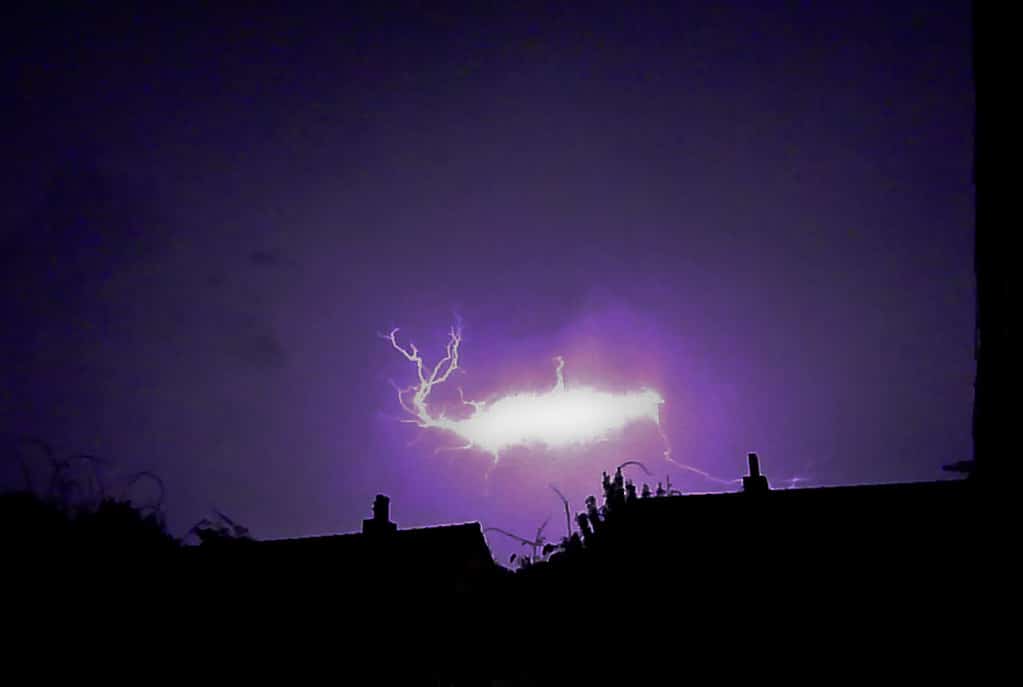
Ball lightning is a relatively rare phenomenon and appears as a spherical ball in the air.
8. St. Elmo’s Fire
St. Elmo’s fire is a unique atmospheric electrical phenomenon that occurs during thunderstorms that appears as a faint, glowing, and sometimes bluish or violet light that emanates from sharp or pointed objects, such as ship masts, aircraft wings, or tall structures, during storms. It is caused by the ionization of the air around these objects due to the strong electric fields present during thunderstorms. St. Elmo’s fire is a kind of plasmic phenomenon instead of lightning, but can often resemble electric bolts and be confused with them. While not hazardous, St. Elmo’s fire has long been associated with seafaring superstitions and is considered a sign of imminent storms.

St. Elmo’s fire is usually seen around ship masts and aircraft wings.
9. Heat Lightning
Heat lightning is a term often used to describe a specific phenomenon related to distant flashes that are visible but do not produce the accompanying sound of thunder. This type is frequently observed during warm summer nights, often over distant horizons. Contrary to popular belief, heat lightning is not a distinct type of lightning but rather a misnomer for the visible flashes of distant lightning storms.
The name “heat lightning” likely originated from the association of such bolts with hot and humid weather conditions commonly experienced during the summer months. The term can lead to misconceptions about the nature of these distant flashes, with some believing that the lack of thunder is due to the phenomenon occurring without any storm clouds nearby.
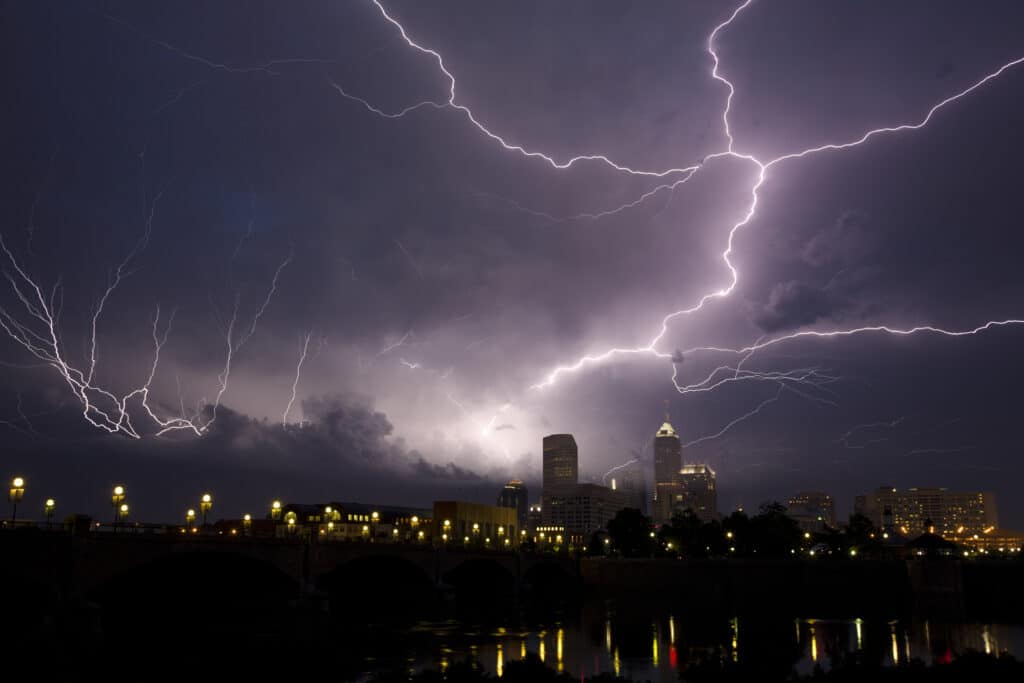
Heat strikes generally have visible lightning bolts, but are not accompanied by the sound of thunder.
©iStock.com/alexeys
10. Positive Lightning
Positive lightning is a relatively rare and powerful type within the cloud-to-ground category. It occurs when the leader stroke initiates from the positively charged region of a thundercloud instead of the negatively charged region as in typical cloud-to-ground lightning. Positive lightning bolts are exceptionally intense and can travel vast distances from the cloud to the ground. They are more likely to strike objects and terrain far from the storm center, making them particularly hazardous to aircraft and ground-level structures.

Powerful lightning bolts strike from a sunset thunderstorm in the Arizona desert.
©mdesigner125/iStock via Getty Images
Most Dangerous Types of Lightning
The most dangerous types are those that pose significant risks to human safety and property. Understanding the characteristics of these dangerous types is essential for taking appropriate safety measures during thunderstorms.
Cloud-to-Ground Lightning (CG)
Cloud-to-ground phenomena are the most perilous type because they directly impact the Earth’s surface. It occurs when an electrical discharge travels from a thundercloud to the ground. CG strikes consist of a “leader” stroke that descends from the cloud and a subsequent “return stroke” that travels back to the cloud along the same path. This type of lightning can strike objects on the ground, including buildings, trees, and people. Extreme temperatures of this type can cause fires and severe burns, and its intense electrical current can be fatal.
Positive Cloud-to-Ground Lightning
Positive cloud-to-ground lightning is even more dangerous than regular CG lightning. It occurs when the electrical discharge initiates from the positively charged region of a thundercloud, rather than the negatively charged region. Positive bolts are exceptionally powerful, can travel vast distances from the cloud to the ground, and are more likely to strike objects far from the storm center. Positive CG strikes are associated with a higher chance of severe injuries and damages.
Cloud-to-Ground Lightning with Multiple Strokes
Some cloud-to-ground strikes consist of multiple strokes that follow the same path. These “multiple stroke” events can be extremely hazardous, as they deliver additional electrical current to the same point on the ground, increasing the risk of severe damage and injury.
Rocket-Triggered Lightning
Rocket-triggered lightning is a type generated for scientific observation. Researchers use rockets with grounded wires to attract lightning strikes during thunderstorms. While the purpose is scientific, these artificially triggered events can be dangerous for those involved in conducting the experiments.
Upward Lightning (Ground-to-Cloud)
Upward lightning, also known as ground-to-cloud lightning, occurs when a lightning strike originates from a tall structure or the ground and travels upwards to a thundercloud. This type can pose risks to tall buildings, transmission towers, and other elevated structures.

Some lightning strikes can be more dangerous than others, especially those that hit the ground.
©Bob Pool/Shutterstock.com
Staying Safe from Lightning
Staying safe from lightning is crucial, as it is a powerful and potentially dangerous natural phenomenon. Lightning strikes can cause severe injuries and even fatalities. Whether you are indoors or outdoors during a thunderstorm, follow safety guidelines to reduce the risk of being struck by bolts. Here are some essential tips on how to stay safe from lightning:
Monitor Weather Forecasts
Stay informed about weather conditions by regularly checking local weather forecasts and updates. Pay attention to thunderstorm warnings issued by meteorological authorities. If weather stations predict thunderstorms in your area, plan your activities accordingly and prepare to take necessary safety precautions.
Seek Shelter Indoors
When thunderstorms approach, the safest place to be is indoors. Seek shelter in a substantial building with wiring and plumbing, such as a house, office building, or shopping mall. Avoid small, isolated structures, sheds, picnic shelters, and beach huts, as they do not provide adequate protection from lightning.
Stay Away from Electrical Appliances and Plumbing
Electric bolts can cause power surges that may damage electrical appliances and equipment. To protect yourself, avoid using electrical devices, corded phones, and plumbing fixtures during a thunderstorm. If you must use electrical equipment, unplug them before the storm arrives.
Avoid Water Activities
Avoid activities like swimming, boating, and other water-related activities during thunderstorms. Bodies of water, such as lakes and swimming pools, are conductors of electricity, and strikes nearby can pose a significant risk to anyone in or near the water.
Stay Away from Windows
Avoid standing near windows during a thunderstorm. If bolts strike the building, shattered glass could pose a threat to your safety. Stay in the middle of a room, away from doors and windows, until the storm passes.
Do Not Seek Shelter Under Trees
Contrary to popular belief, seeking shelter under trees is not safe during a thunderstorm. Trees can attract electric bolts, and if struck, the electrical current can travel through the ground and pose a danger to anyone standing nearby. Stay away from trees and tall objects during a storm.
Wait for 30 Minutes After the Last Thunderclap
After the last clap of thunder, wait at least 30 minutes before leaving your shelter. Lightning can strike from distant thunderstorms, and it may take some time before the immediate danger has passed. Give yourself ample time to ensure it is safe to go outside.
Understand the 30-30 Rule
The 30-30 rule is a useful guideline for estimating the distance of a thunderstorm. When you see flashes of light, count the seconds until you hear thunder. If the time between the flash and the thunder is less than 30 seconds, the storm is within 6 miles (10 kilometers) and poses an immediate threat. Seek shelter promptly and remain there for at least 30 minutes after the last thunderclap.
Encourage Lightning Safety Education
Promote lightning safety awareness among family, friends, and community members. Teach children about the dangers of lightning and the importance of seeking shelter during thunderstorms. Encouraging safety education helps create a culture of preparedness and reduces the risk of lightning-related accidents.
Summary of the Most Common Types of Lightning
| Number | Common Type of Lightning |
|---|---|
| 1 | Intra-Cloud Lightning (IC) |
| 2 | Cloud-to-Ground Lightning (CG) |
| 3 | Cloud-to-Cloud Lightning (CC) |
| 4 | Forked Lightning |
| 5 | Ribbon Lightning |
| 6 | Bead Lightning |
| 7 | Ball Lightning |
| 8 | St. Elmo’s Fire |
| 9 | Heat Lightning |
| 10 | Positive Lightning |
The photo featured at the top of this post is © mdesigner125/iStock via Getty Images
Thank you for reading! Have some feedback for us? Contact the AZ Animals editorial team.







